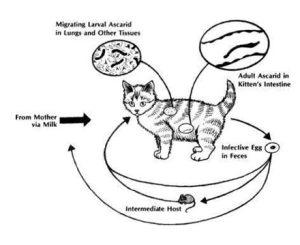The Classic Comprehensive Handbook of Cat Care: ROUNDWORMS (NEMATODES)
Although most people are aware that roundworm infections occur in cats, many are unaware that, like the other classes of internal parasites, there are several kinds of roundworms. Common ones are covered in the following pages.
ASCARIDS
Ascarids are the type of roundworms commonly seen in the stool of kittens. They are white, cylindrical, and pointed at both ends. They may be relatively small and threadlike in appearance or as long as 3 or 4 inches (around 7 to 10 cm), somewhat resembling small white earthworms. Adult ascarids live in the small intestine and get their nourishment by absorbing nutrients in the digestive juices through their cuticle (outer covering).
Mature ascarids produce eggs that pass out in the cat’s stool. After about one to four weeks the eggs become infective and contain larval worms. If the infective eggs are ingested by an appropriate host, they complete their life cycle, eventually becoming adult worms in the host’s intestine. If they are eaten by an inappropriate host, such as a rodent or cockroach, the larval worms encycst in the tissues of the host where they remain unless a cat or other animal eats the abnormal host and through digestion releases the larvae.
ASCARID LIFE CYCLE

ASCARID INFECTION MAY OCCUR SOON AFTER BIRTH
Larvae of the common cat roundworm, Toxocara cati, can be transmitted from an adult female cat through her milk to nursing kittens, so infection may be found in very young cats. It is impossible to prevent this early infection by deworming the female before she gives birth. Therefore, it is probably easiest and best in terms of possible effects on human health to assume that all kittens have ascarid infections and to deworm them routinely.
SIGNS OF ASCARID INFECTION
Ascarids do not usually cause apparent disease in adult cats, however, heavy infections with Toxocara cati in kittens in particular, can lead to death. This roundworm migrates through the lungs en route to the intestine and can cause a cough or even pneumonia. More commonly, vomiting (of worms, sometimes), diarrhea, and progressive weakness are seen. Severely infected kittens may have dull coats and potbellies on a thin frame, and some may even develop bowel obstruction or rupture from impaction with ascarid roundworms.
ASCARID TREATMENT
The drugs piperazine (at a dose of 50 mg/lb body weight base, 110 mg/kg body weight base) and pyrantel pamoate (9 mg/lb, 20 mg/kg) are used to remove adult ascarids from the intestines. Both are very safe and effective drugs that you can obtain from your veterinarian or a pet shop; both drugs can be administered at home. There is no need to make your cat fast before administering the dewormers, and they do not usually cause vomiting or diarrhea. Avoid over-the-counter products containing dichlorophene and/or toluene since these have been associated with toxicity. Other drugs used to kill ascarids may be available only with a prescription from a veterinarian. These include febantel, fenbendazole, dichlorvos, and ivermectin. Kittens can be dewormed as early as four weeks after birth in order to remove ascarids before they start shedding eggs into the stool, resulting in environmental contamination. Public health authorities strongly recommend this procedure. Deworming should be repeated at least once two to four weeks later to remove any adult worms that were immature and not killed at the first dosing. For extremely heavy infections, deworming may have to be repeated several times before all worms present are killed. Therefore, it is common to deworm kittens every two to three weeks until they are three months of age.
Ascarid eggs are very resistant to environmental stresses. They can remain alive and infective for months or years once they have contaminated soil. These factors make it very important to practice good sanitation to prevent reinfection of your cat as well as infection of other cats and humans. Roundworm eggs cannot survive on surfaces that dry completely and that are exposed to sunlight as much as possible. Surfaces should be thoroughly cleaned with iodine-based disinfectants containing 120 parts per million free iodine. A 1% sodium hypochlorite solution (3 cups liquid chlorine laundry bleach to 1 gallon water) will damage but not kill roundworm eggs as an aid to removal. Rodents and cockroaches, which may serve as intermediate hosts for the worms, should be controlled.
ASCARIDS ARE A HUMAN HEALTH HAZARD
Although feline ascarids do not occur in human intestines, their larve may cause visceral larva migrans, a rare condition in which roundworm larvae migrate throughout the body. Visceral larva migrans may cause anything from no signs of illness to severe signs, including blindness. The condition occurs most often in young children who play in soil infested with the eggs of the common dog roundworm, Toxocara canis, and put their contaminated hands in their mouths. But Toxocara cati has been incriminated in some cases. Although complete recovery is the rule, the possibility of human infection is a significant reason for good ascarid control and for good general hygiene.